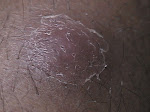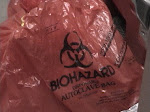Cutaneous (skin) infection is the most common form of the disease. It occurs when the spores come in contact with an area of skin that is broken, such as a cut or a sore. Cultaneous anthrax is marked by an itchy, blister-like lesion that eventually forms a boil with a black center. The boils respond well if treated with antibiotics right away.
Symptoms may develop one to six days after exposure to the germ. Since the anthrax germ can live for a long time in the environment, symptoms may not start for up to 60 or more days after the germ has released into the air.
If the germ gets into your skin, your skin will have small sore that will become a blister. The blister then develops into a boil with a black area in the center.
The Centers for Disease Control and Prevention (CDC) classify agents with known bioterrorism potential into three priority areas (A, B and C). Anthrax is ranked as a Category A agent. Category A agents are those that:
•
pose the greatest threat to public health
•
may spread across a large area or need public awareness
•
need a great deal of planning to protect the public’s health
NELSON MANDELA ON SPORTS
12 years ago


























